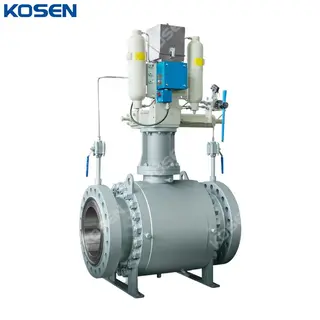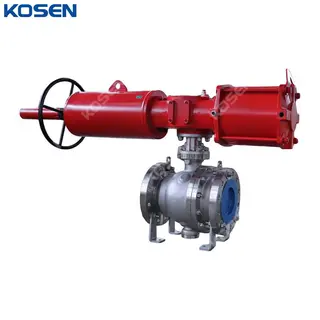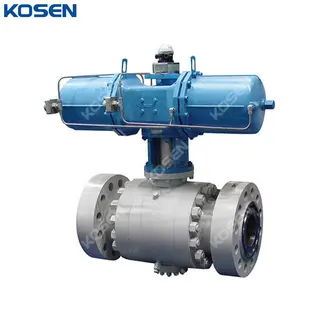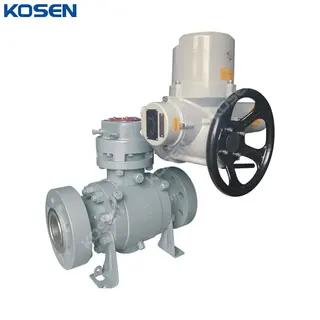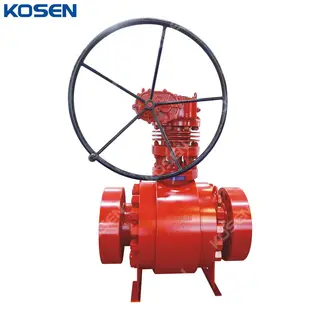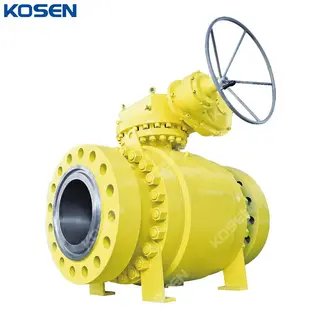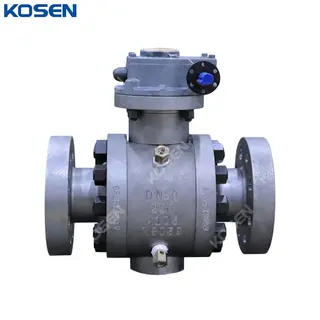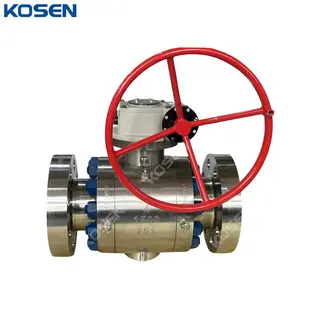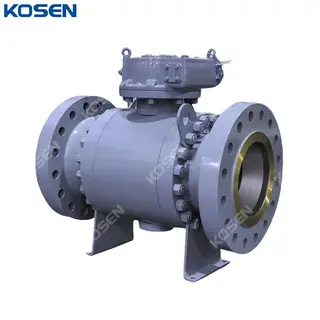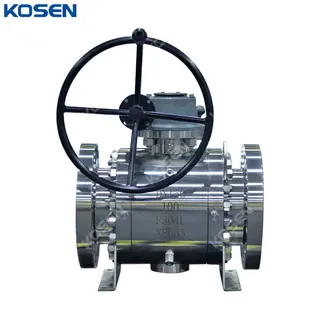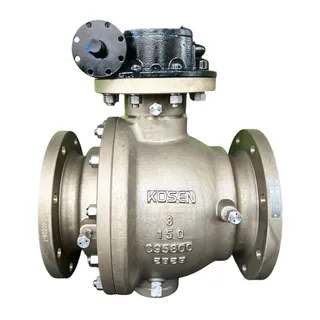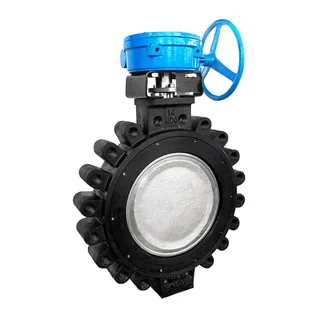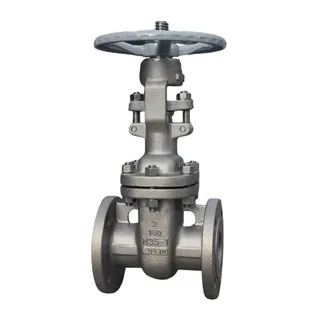A ball valve consists of several key components, each of which plays an important role in ensuring the normal operation of the valve.
Valve Body: The valve body is the primary component of the ball valve, housing all the components required for opening and closing control. It provides the overall framework and support for the valve.
Rotating Ball: The rotating ball has a central hole through which the medium flows. The direction of the ball is controlled by the rotation of the valve stem, thereby controlling the flow of the fluid.
Valve Stem: The valve stem connects the ball to the external operating mechanism. One end passes through the ball and connects to it, while the other end connects to the actuator. The stem is rotated or moved by the actuator (e.g., manual lever or electric actuator) to rotate the ball and control the opening and closing of the pipeline.
Seat: The seat is positioned between the valve body and the ball, providing sealing and supporting the ball. It is typically made from metal, plastic, or elastic materials. The seat often features grooves that match the rotating ball, forming a seal to prevent leakage of the medium.
Power Source: The valve stem is rotated manually or driven by a power source. Manual operation is typically controlled by a lever or handle, while automated driving sources may include electric, pneumatic, or hydraulic systems, often controlled by electrical or pneumatic signals to rotate the ball for automatic control.
Packing: The packing is the sealing element around the valve stem, preventing the medium from leaking at the stem and ensuring the valve's sealing performance.
Valve Cover: The valve cover is part of the valve body and surrounds and protects the stem and packing, ensuring the normal operation of these internal components.
Ball valves can be classified into various types based on their structure, usage, and other factors. Each type of ball valve has its specific advantages and is suited for particular applications.
One-Piece Ball Valve: The valve body is made from a single solid casting, offering a compact and robust design. However, due to its non-removable nature, maintenance is more difficult, making it typically considered a "single-use" valve.
Two-Piece Ball Valve: Consists of a valve body and an end connector. Although it can be disassembled for maintenance, the threaded parts may experience wear when disassembled, increasing maintenance complexity.
Three-Piece Ball Valve: Composed of the body and two pipeline connectors. The body can be connected to the pipeline by threading or welding. The advantage of the three-piece design is that the body can be easily removed for cleaning or maintenance without disassembling the pipeline connectors, making regular maintenance more convenient.
Ball valves can be categorized into several types based on their structural design.The most common types of ball valves by structure are as follows.
Structure: The ball is in a floating state, and under the pressure of the medium, the ball moves slightly and seals tightly against the sealing surface at the outlet.
Advantages: Simple structure, good sealing performance.
Disadvantages: The ball's working load is fully transmitted to the outlet sealing ring, requiring particular attention to the durability of the sealing ring material.
Applications: Mainly used for medium and low-pressure ball valves.
Structure: The ball remains fixed and does not move under pressure. The valve seat moves under the pressure of the medium, pressing the sealing ring tightly against the ball to ensure sealing.
Advantages: Suitable for high-pressure and large-diameter valves, small operating torque, and stable sealing.
Common Design: Typically equipped with bearings on the upper and lower shafts of the ball to reduce operating torque.
Structure: The ball is elastic, and the sealing ring is usually made from metal. Since the sealing pressure is large and cannot rely solely on the medium pressure, external force must be applied to achieve the sealing effect.
Application Environment: Especially suitable for high-temperature and high-pressure media.
Design Features: The lower end of the ball has an elastic groove, and the wedge-shaped head of the valve stem can make the ball elastically open, thus forming a compressed seal with the valve seat. When closing, the wedge-shaped head is loosened, the ball returns to its original shape, reducing friction on the sealing surface and lowering operating torque.
A ball valve is a quarter-turn valve that operates similarly to a plug valve or butterfly valve, using the rotation of the ball to control the flow of the medium. Ball valves can be manually operated or controlled automatically via actuators.
In the simplest form, an operator uses a wrench or lever to manually rotate the ball valve. Applying torque rotates the lever arm 90° clockwise or counterclockwise, thus opening or closing the valve:
When the lever arm is parallel to the pipeline, the valve is in the open state.
When the lever arm is perpendicular to the pipeline, the valve is in the closed state.
The operation of the ball valve is straightforward, relying on the ball's rotation to open and close the valve.
Open State: When the ball rotates 90°, the internal passage of the ball aligns with the inlet and outlet of the pipeline, forming a continuous passage for the medium to flow through.
Closed State: When the ball rotates another 90°, the passage of the ball is perpendicular to the pipeline's inlet and outlet, cutting off the flow of the medium and closing the valve.
Open State: The flow passage of the ball valve is approximately the same diameter as the pipeline, causing minimal flow resistance and almost no pressure loss. This makes ball valves ideal for rapid fluid flow shutoff or flow control.
Closed State: When closed, the spherical surface of the ball completely seals off the pipeline, completely cutting off the medium flow.
Ball valves are widely used in industrial and pipeline control systems. Their unique design and superior performance make them the valve of choice for many applications, but they also have some limitations that can affect their suitability for certain specific scenarios.
Superior Sealing Performance: The ball tightly fits with the valve seat. Soft-seal materials like rubber or PTFE achieve zero leakage, while hard-seal ball valves use metal-to-metal seals that maintain good sealing under high temperature and pressure conditions.
Ease of Operation: The ball can be quickly rotated 90° via a small torque, making it easy to open or close, saving time and improving operational efficiency.
Low Flow Resistance: When fully open, the ball valve's flow passage aligns with the pipeline's diameter, allowing for smooth fluid flow with minimal pressure loss, thus reducing energy consumption.
Compact Size and Easy Maintenance: Smaller ball valves are lightweight, with fewer components, making installation and maintenance easy. They occupy less installation space.
Wide Applicability: Suitable for a variety of media, including water, oil, gas, steam, and corrosive media like acids, alkalis, and salts, even capable of handling media with particles.
Durability: With a solid structure and high-quality materials, ball valves can withstand long-term use and wear. Full-welded body ball valves can last up to 30 years.
Additional Functions: Some ball valves feature anti-static functionality, dissipating static electricity generated during switching. V-shaped ball valves also offer excellent flow control.
Manufacturing Difficulty: The machining and grinding of the ball require high manufacturing precision and equipment, ensuring sealing performance; otherwise, leakage or operational issues may arise.
Temperature Limitations: The main sealing materials like PTFE have limited temperature resistance, typically only usable below 180°C, with long-term use recommended under 120°C to prevent aging and seal degradation.
Poor Adjustment Performance: Pneumatic or electric ball valves have lower flow adjustment accuracy and linearity compared to specialized control valves like globe or throttling valves.
High Manufacturing Cost: Due to their complex structure, especially for large diameter, high pressure, high temperature, or special material ball valves, manufacturing costs can be high.
Oil and Chemical Industry: Floating ball valves are widely used in crude oil pipelines and chemical production plants to control flow and direction, ensuring system safety and efficient operation while preventing leakage and contamination.
Power Industry: Floating ball valves regulate the flow of cooling water, steam, and condensate in thermal and nuclear power plants to ensure the efficient and safe operation of power generation systems.
Water Supply and Drainage Systems: Floating ball valves regulate water flow in urban water supply and wastewater treatment systems, ensuring stable treatment processes and improving sewage treatment efficiency, as well as responding quickly in emergencies.
Pharmaceutical Industry: Control the flow of raw materials and finished products, ensuring stable production processes and preventing contamination to maintain product quality.
Food and Beverage Industry: In beverage production, floating ball valves control flow rates to ensure production precision and product quality.
Shipbuilding Industry: Floating ball valves are used in marine pipeline systems to regulate the flow of fuel, cooling water, and other media, ensuring the safety of the ship's operation.
Selecting a ball valve requires considering multiple factors to ensure that the valve meets specific application requirements. Here are the basic considerations.
Before choosing a ball valve, it's essential to understand the properties of the fluid, including its type, temperature, pressure, and flow rate. Different fluids will have different material and sealing requirements, which will impact the valve's pressure tolerance and flow characteristics. Ensure that the material, size, and seat materials are appropriate for the fluid and operating conditions.
The choice of ball valve should also take into account the switching frequency, differential pressure, and service life. For applications requiring frequent operation, select a valve designed for high-frequency use to ensure reliable sealing and a long service life. In high-pressure conditions, ensure that the valve can withstand the required pressure and that its material and structure are robust enough for the application.
Consider the safety features of the valve, such as leakage prevention, fire resistance, and explosion-proof design. The valve's sealing performance and compliance with safety standards are crucial to ensure safe operation during use.
When selecting a ball valve, consider the environmental conditions such as working temperature, climate, and corrosive environments. In extreme conditions, choose valves made from corrosion-resistant, high-temperature, or low-temperature materials to ensure the valve's stability and reliability.
5. Maintenance and Care Requirements
Think about the ease of maintenance and the associated costs. A well-designed ball valve should be easy to clean and maintain, reducing maintenance costs and prolonging the valve's life. Consider whether the valve's structure allows for easy servicing and whether the maintenance requirements are manageable.
Proper installation is crucial for ensuring the valve's normal operation, sealing performance, and longevity. Below are the steps and precautions for installing a ball valve.
Ensure that the pipework is aligned and that the flanges are parallel. The piping must support the valve's weight, adding supports if necessary.
Clean the pipeline by blowing through it to remove oil, welding slag, or other impurities.
Check the valve to ensure it is intact, and perform several open-close operations to ensure proper function.
Remove any protective covers from the valve's flanges and clean the valve ports to avoid damage to the seat seal.
The valve can be installed in any position along the pipeline. For manual valves, installation position is flexible. For valves with gearboxes or actuators, ensure the valve is installed upright with the actuator positioned above the pipeline.
Place the appropriate gasket between the valve and pipeline flanges, according to the design specifications.
Tighten the flange bolts evenly, starting symmetrically to ensure an even seal.
For pneumatic actuators, connect the necessary pneumatic lines.
3. Post-Installation Checks
Operate the actuator to open and close the valve several times to ensure it moves smoothly without any stiffness, confirming proper operation.
Check the sealing performance between the valve and pipeline flanges to ensure no leaks.
Ball Valve Maintenance and Care
Regular maintenance is key to ensuring the valve's long-term stability. Here are the essential maintenance practices.
Sealing Performance Check: Regularly check the sealing of the valve to ensure there are no leaks. If sealing performance deteriorates, replace the sealing elements promptly to avoid system impact.
Valve Stem and Body Inspection: Inspect the valve stem and body for damage, corrosion, or any signs of degradation. If any issues are found, repair or replace the affected parts.
Actuation Mechanism Check: Regularly inspect the valve's actuating mechanism to ensure it operates correctly. If there are signs of malfunction (e.g., sticking or rough operation), repair or replace the components as necessary.
Lubrication Maintenance: Lubricate the moving parts of the valve regularly to reduce wear and extend its life. If the lubrication is inadequate, replace the lubricant to ensure smooth operation.
Cleaning: Periodically clean both the interior and exterior of the valve to remove dust, oil, and other contaminants. Ensure that the ball and seat are cleaned regularly to prevent debris from interfering with valve operation.
Bolt Tightening Check: Check the bolts on the valve to ensure they are not loose. Loose bolts can impact the valve's performance and sealing, so tighten them as needed.
Pipeline Connection Check: Regularly check the valve's connections to the pipeline to ensure there are no leaks. Address any leakage issues promptly to avoid system failures.
Functional Performance Test: Conduct regular functionality tests to ensure the valve opens and closes smoothly. If the valve shows signs of resistance or fails to operate correctly, inspect and replace faulty components.
